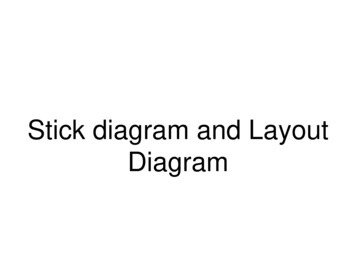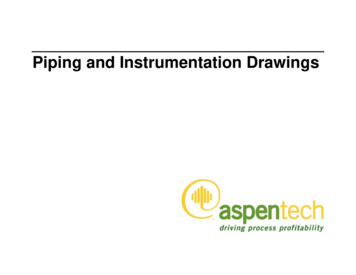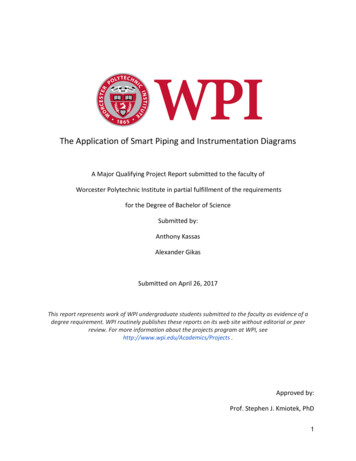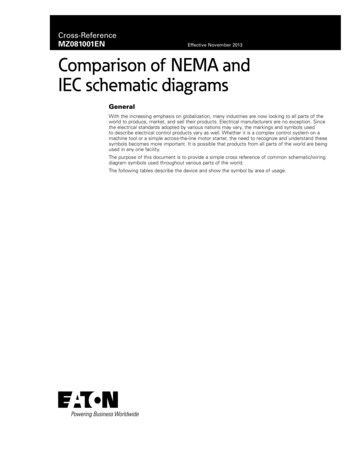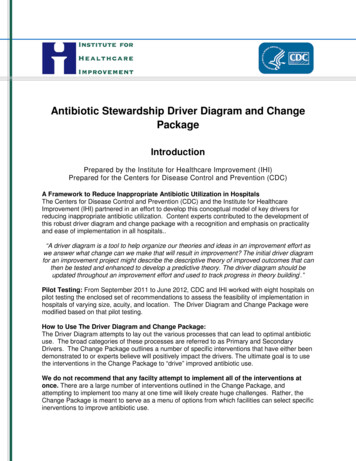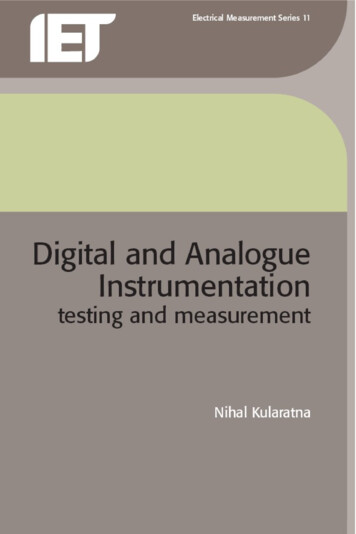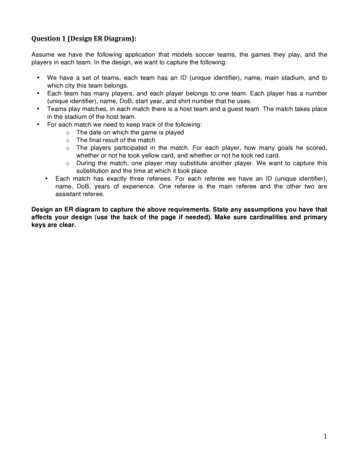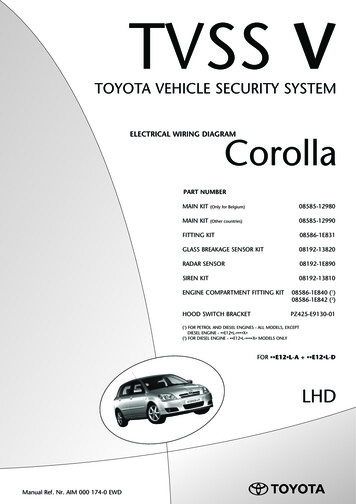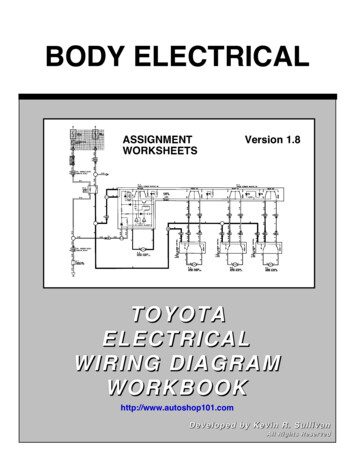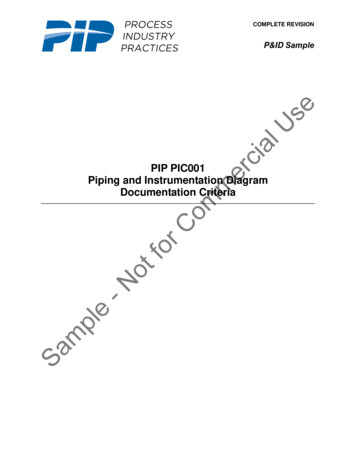
Transcription
COMPLETE REVISIONcialUseP&ID SampleSample-NotforCommerPIP PIC001Piping and Instrumentation DiagramDocumentation Criteria
PURPOSE AND USE OF PROCESS INDUSTRY PRACTICESrCommercialUseIn an effort to minimize the cost of process industry facilities, this Practice has beenprepared from the technical requirements in the existing standards of major industrial users,contractors, or standards organizations. By harmonizing these technical requirements into a singleset of Practices, administrative, application, and engineering costs to both the purchaser and themanufacturer should be reduced. While this Practice is expected to incorporate the majority ofrequirements of most users, individual applications may involve requirements that will be appendedto and take precedence over this Practice. Determinations concerning fitness for purpose andparticular matters or application of the Practice to particular project or engineering situations shouldnot be made solely on information contained in these materials. The use of trade names from timeto time should not be viewed as an expression of preference but rather recognized as normal usagein the trade. Other brands having the same specifications are equally correct and may be substitutedfor those named. All Practices or guidelines are intended to be consistent with applicable laws andregulations including OSHA requirements. To the extent these Practices or guidelines shouldconflict with OSHA or other applicable laws or regulations, such laws or regulations must befollowed. Consult an appropriate professional before applying or acting on any material containedin or suggested by the Practice.This Practice is subject to revision at any time.mple-Notfo Process Industry Practices (PIP), Construction Industry Institute, The University of Texas atAustin, 3925 West Braker Lane (R4500), Austin, Texas 78759. PIP Member Companies andSubscribers may copy this Practice for their internal use. Changes or modifications of any kind are notpermitted within any PIP Practice without the express written authorization of PIP. Authorized Usersmay attach addenda or overlays to clearly indicate modifications or exceptions to specific sections ofPIP Practices. Authorized Users may provide their clients, suppliers and contractors with copies of thePractice solely for Authorized Users’ purposes. These purposes include but are not limited to theprocurement process (e.g., as attachments to requests for quotation/ purchase orders or requests forproposals/contracts) and preparation and issue of design engineering deliverables for use on a specificproject by Authorized User’s client. PIP’s copyright notices must be clearly indicated andunequivocally incorporated in documents where an Authorized User desires to provide any third partywith copies of the Practice.SaNote: PIP PIC001, Piping and Instrumentation Diagram Documentation Criteria, incorporates symbolspreviously published in standards owned and copyrighted by The Instrumentation, Systems, and AutomationSociety (ISA). These are printed with agreement from ISA.PUBLISHING HISTORYNovember 1998IssuedApril 2008Complete RevisionNot printed with State funds
COMPLETE REVISIONApril 2008cialUseP&IDTable of ContentsrCommerPIP PIC001Piping and Instrumentation DiagramDocumentation Criteria1. Introduction .2fo1.1 Purpose .21.2 Scope .22. References .2-Not2.1 Process Industry Practices .32.2 Industry Codes and Standards .32.3 Government Regulations .33. Definitions .34. Requirements .6eGeneral .6Format .6Equipment .11Piping .17Instrumentation and Controls .20mpl4.14.24.34.44.5SaAppendixesAppendix A – Detailed Equipment LabelsPIC001-A-001-1 – Appendix A – SuggestedDetailed Equipment LabelsPIC001-A-001-2 – Appendix A – SuggestedDetailed Equipment LabelsAppendix B – Legend SheetsPIC001-B-001 – Appendix B-1 – TypicalPiping Legend SheetPIC001-B-002 – Appendix B-2 – TypicalInstrumentation Legend SheetProcess Industry PracticesPIC001-B-003-1 – Appendix B-3 – DrivenEquipment Legend SheetPIC001-B-003-2 – Appendix B-3 – HeatTransfer Equipment Legend SheetPIC001-B-003-3 – Appendix B-3 – Vessels &Tanks Legend SheetPIC001-B-003-4 – Appendix B-3 – Solids &Material Handling Equipment Legend SheetPIC001-B-003-5 – Appendix B-3 – Fire &Safety Equipment Legend SheetPIC001-B-004 – Appendix B-4 – TypicalDetails with Implied ComponentsAppendix C – Example P&IDsPIC001-C-001 – Appendix C-1 – ExampleProcess P&ID 1PIC001-C-002 – Appendix C-2 – ExampleProcess P&ID 2PIC001-C-003 – Appendix C-3 – ExampleUtility P&IDAppendix D – P&IDs for the Hygienic ProcessingIndustriesPIC001-DB-001 – Appendix DB-1 – HygienicProcess Piping Legend SheetPIC001-DB-002 – Appendix DB-3 – HygienicProcess Equipment Legend SheetPIC001-DC-001 – Appendix DC-1 – HygienicProcess Example Process P&ID 1PIC001-DC-002 – Appendix DC-2 – HygienicProcess Example Process P&ID 2PIC001-DC-003 – Appendix DC-3 – HygienicProcess Example Process P&ID 3Page 1 of 43
COMPLETE REVISIONPIP PIC001Piping and Instrumentation Diagram Documentation Criteria1.April 2008Introduction1.1PurposeThis Practice provides requirements for designers preparing Piping and InstrumentationDiagrams (P&IDs).Scopese1.2UThis Practice describes the requirements for P&ID format and content. The Practice isindependent of time in a facility life cycle and encompasses design, construction,operations, and maintenance.ercialThis Practice covers the generation of new P&IDs and does not apply to the revision ofexisting P&IDs. This Practice also applies to P&IDs provided by packaged equipmentvendors.This Practice applies to all diagrams that fit the definition of a P&ID in Section 3.mThe requirements provided in this Practice can be applied to any CAD system used fordeveloping the P&IDs and are not vendor, hardware, or software specific.ComThe requirements provided in this Practice provide a balance between showing all data onP&IDs and making P&IDs legible and easy to read. While this Practice is expected toincorporate the majority of requirements of most users, individual applications mayinvolve requirements that will be appended to and take precedence over this Practice.Determinations concerning fitness for purpose and particular matters or application of thePractice to particular project or engineering situations should not be made solely oninformation contained in these materials.NoThe example P&IDs included in the Appendixes of this Practice are not intended torecommend specific design details or requirements. Example P&IDs are included toprovide an illustration of how the elements of this Practice are combined into a P&ID.Sample-Electronic native files for the text, symbols, and cover sheets are available to PIPMember Companies for input to members’ CAD systems. Development of projectspecific cover sheets is recommended using the PIP native files as a starting point.Additions and/or deletions are allowed to meet requirements. Cover sheet borders andtitle blocks can be altered.2.ReferencesApplicable parts of the following Practices, industry codes and standards, and references shall beconsidered an integral part of this Practice. The edition in effect on the date of start of P&IDdevelopment shall be used, except as otherwise noted. Short titles are used herein whereappropriate.2.1Process Industry Practices (PIP)– PIP INEG1000 – Insulation Design and Type Codes– PIP PCCIP001 – Instrument Piping and Tubing Systems Criteria– PIP PCSIP001 – Instrument Piping and Tubing Systems SpecificationsPage 2 of 31Process Industry Practices
COMPLETE REVISIONPIP PIC001Piping and Instrumentation Diagram Documentation CriteriaApril 2008– PIP PNE00001 – Design of ASME B31.3 Metallic Piping Systems– PIP PNSM0001 – Piping Line Class Designator System2.2Industry Codes and Standards American National Standards Institute (ANSI)– ANSI/FCI 70-2-2003 – Control Valve Seat Leakage seAmerican Society of Mechanical Engineers (ASME)– ASME Boiler and Pressure Vessel Code USection VIII – Pressure VesselsThe Instrumentation, Systems, and Automation Society (ISA)ercial– ISA 5.1 – Instrumentation Symbols and Identification– ISA 5.2 – Binary Logic Diagrams for Process Operations– ISA 5.3 – Graphic Symbols for Distributed Control / Shared DisplayInstrumentation, Logic and Computer Systems CoGovernment RegulationsmTubular Exchanger Manufacturers Association (TEMA)– TEMA Standards2.3m– ISA 84.01 – Application of Safety Instrumented Systems for the Process Industries Occupational Safety and Health Administration (OSHA)3.DefinitionsNo– OSHA 29 CFR 1910.119 – Occupational Safety and Health Standards, ProcessSafety Management of Highly Hazardous Chemicalse-For the purposes of this Practice, the following definitions apply:Samplaccessible: Term applied to a device or function that can be used or seen by an operator for thepurpose of performing control actions (e.g., set point changes, auto-manual transfer, or on/offactions) (Reference ISA 5.1)automated valve: Any valve with a locally or remotely controlled actuator. Examples arethrottling control valves and on/off block valves. Actuators are typically air-operated (diaphragmor piston), electric or hydraulic, some with a spring-return function. Manually-operated valves aresometimes tagged as automated valves (e.g., if a manual valve is fitted with position switches).auxiliary P&ID: Used to show details to unclutter other P&IDs (e.g., lube oil system, samplesystems, instrument details)Basic Process Control System (BPCS): Control equipment and system installed to regulatenormal production functions. It may contain combinations of single-loop pneumatic controllers,single-loop electronic controllers, Programmable Logic Controllers (PLCs), and DistributedControl Systems (DCSs). The BPCS is required to operate the process. Examples of controlProcess Industry PracticesPage 3 of 31
COMPLETE REVISIONPIP PIC001Piping and Instrumentation Diagram Documentation CriteriaApril 2008functions included in the BPCS are cascade control, override control, and pump start/stop. Alsoknown as Basic Regulatory Controls. (See also HLCS and SIS)bubble: Circular symbol used to denote and identify the purpose of an instrument or function. Thebubble usually contains a tag number. (Synonym for balloon) (Reference ISA 5.1)sedesign pressure: Pressure used in the design of a vessel component together with the coincidentdesign metal temperature for determining the minimum permissible thickness or physicalcharacteristics of the different zones of the vessel. (Reference ASME Boiler Pressure VesselCode, Section VIII, Division 1, Appendix 3)Ufail closed (FC): Characteristic of an automated valve that causes the valve to close as a result ofspecific malfunctions, including loss of signal or motive power. (Reference ISA 5.1)ercialfail indeterminate (FI): Characteristic of an automated valve that causes the valve to move to anunknown position as a result of specific malfunctions, including loss of signal or motive power.Some automated valves will not stay at the last position upon failure and instead move with theprocess differential pressure. Additional equipment may be needed to meet the definition of FC,FO, or FL. (Reference ISA 5.1)mmfail locked (FL) last position: Characteristic of an automated valve that causes the valve to remain inthe last (locked) position as a result of specific malfunctions, including loss of signal or motive power.Automated valves may fail indeterminately without additional equipment. (Reference ISA 5.1)Cofail open (FO): Characteristic of an automated valve that causes the valve to open as a result ofspecific malfunctions, including loss of signal or motive power. (Reference ISA 5.1)ohand switch (HS): Any operator-manipulated discrete control device, including hardwired panelswitches and software points.e-Nheat exchanger type: Type designation shall be shell and tube, plate and frame, spiral, etc. Forshell and tube exchangers, use the three-letter designation describing stationary head, shell, andrear end or head, in that order, in accordance with TEMA.SamplHigher Level Control System (HLCS): Provides sophistication above that of the BPCS. TheHLCS is not necessary to operate the process. HLCS functions are typically based in processcomputers or higher level DCS hardware that interacts with the process by manipulating setpoints in the BPCS. Examples of control functions in the HLCS are statistical process control andmodel predictive control. (See also BPCS and SIS)interlock: System that, in response to a predetermined condition, initiates a predefined action.Typically comprised of binary (on/off) signals and logic used for process control, sequencing, orprotective interruption of normal process control functions. Protective interlocks are typicallyfurther defined as being either safety-related or commercial-related (asset or productionprotection).isolation valve: A valve used for isolation of process equipment while performing activities suchas purging, de-pressuring or de-inventorying. This valve is also commonly referred to as theprimary block valve.line class: Section of the Piping Material Specifications that provides a listing of pipingcomponents for specific design conditions.Page 4 of 31Process Industry Practices
COMPLETE REVISIONPIP PIC001Piping and Instrumentation Diagram Documentation CriteriaApril 2008logic solver: Control equipment that performs the logic function. It can be either hardwired (e.g.,relays) or Programmable Electronic Systems (e.g., DCS-based or PLC-based, including dualredundant or triple-redundant microprocessors).packag
– ISA 5.3 – Graphic Symbols for Distributed Control / Shared Display Instrumentation, Logic and Computer Systems . Piping and Instrumentation Diagram Documentation Criteria April 2008 functions included in the BPCS are cascade control, override control, and pump start/stop. Also known as Basic Regulatory Controls. (See also HLCS and SIS) bubble: Circular symbol used to denote and .
